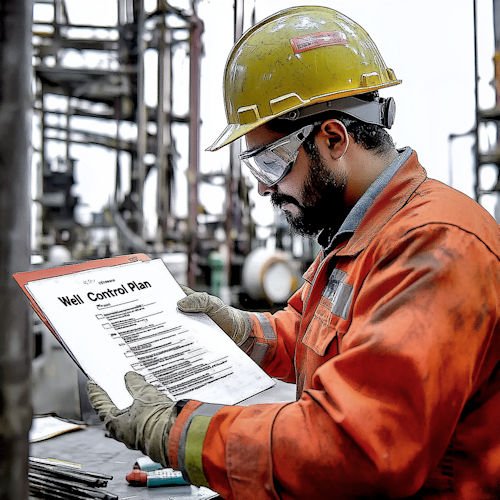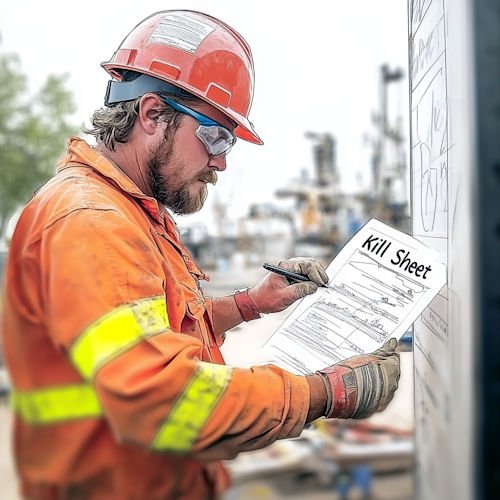 A kill sheet and well control plan are critical documents used in both surface and subsea well control operations to ensure a quick, effective response in the event of a well control issue (e.g., a kick or blowout).
A kill sheet and well control plan are critical documents used in both surface and subsea well control operations to ensure a quick, effective response in the event of a well control issue (e.g., a kick or blowout).
These documents outline the key parameters and actions needed to regain control of the well safely. While the key elements for both surface and subsea kill sheets are similar, subsea operations involve additional considerations due to the complexity of having a remote BOP stack sitting on the sea floor.
Key Elements of a Kill Sheet and Well Control Plan
A completed kill sheet together with a well control plan will either directly or indirectly indicate to the crew the following:
- Well Identification Information
- Well Name and Number: Unique identifiers for the well being drilled.
- Rig Name and Location: Identifies the rig performing the operation and the location of the well.
- Date and Shift: Date and shift for which the kill sheet is being filled out, ensuring the information is relevant for the crew on duty.
- Well Control Parameters
- Mud Weight (Current): The weight of the drilling fluid currently in use. This is important for determining the ability to control pressure.
- Desired Kill Mud Weight: The calculated mud weight required to counteract the formation pressure in case of a kick. This is typically heavier than the current mud weight.
- Shut-In Pressure (SIP): The pressure on the well when the blowout preventers (BOPs) are closed after detecting a kick. This is important for estimating the severity of the kick.
- Formation Pressure: The estimated pressure of the formation being drilled, which is important for calculating the mud weight needed to control the well.
- Casing Pressure: The pressure inside the casing, typically monitored closely during well control events to ensure the integrity of the well.
- Kick Tolerance: The volume of gas or fluid the well can tolerate before the pressure becomes uncontrollable.
- Kick Volume and Management
- Initial Kick Volume: The amount of formation fluid entering the well (kick) at the onset of the problem.
- Total Kick Volume Estimate: The total estimated volume of formation fluids to be circulated out.
- Mud Circulation Rate: The rate at which kill mud will be pumped to counteract the pressure and manage the well.
- Kick Management Procedure: The procedure that the crew should follow to control the kick, including specific steps for circulation, pumping, and monitoring.
- BOP Configuration and Control
- *BOP Stack Type and Configuration: The configuration of the BOP system, which may include various rams (pipe rams, blind rams, shear rams) and annular preventers.
- *BOP Test Results: Recent pressure testing results, ensuring that the BOP system can handle the expected pressures during a well control situation.
- *Choke Settings: Choke manifold settings that control the flow of fluids during well control. The kill sheet will specify the necessary choke settings based on the well control procedures.
- Pressure Control Procedures
- Circulation Method: The method of circulation to be used, such as:
- Reverse Circulation: Pumping the kill mud in reverse order through the system.
- Direct Circulation: Standard circulation method used to remove the kick fluids from the well.
- Desired Bottom Hole Pressure (BHP): The pressure that should be maintained at the bottom of the well during circulation to keep formation fluids under control.
- *Pump Rate: The rate at which kill mud will be pumped through the system to circulate the kick fluids out and regain control of the well.
- Mud Properties and Adjustments
- Mud Type: The type of drilling fluid being used (e.g., water-based, oil-based mud) and its properties.
- Mud Weight Adjustments: Instructions for adjusting the mud weight as needed during the well control operation.
- Mud Circulation Volumes: Volume of mud to be circulated to remove the kick fluid from the wellbore and return the well to a safe condition.
- Roles and Responsibilities need to be predetermined in the well-control plan
- Personnel Involved: A list of key personnel, such as the driller, toolpusher, well control specialists, and safety officers.
- Responsibilities: Clear roles for each member of the team during the well control event, ensuring effective communication and action.
- Communication Protocol
- Communication Plan: Established protocols for notifying team members, the rig management team, and any third-party experts (such as a well control specialist or emergency response team) in the event of a well control issue.
- Emergency Contacts: Contact information for key personnel, both on the rig and for external support teams.

Key Elements for Surface and Subsea Kill Sheets
While surface and subsea kill sheets share many common elements, subsea kill sheets have additional considerations due to the challenges of working at the seabed. Here’s a breakdown of the elements that are specific to each type of operation:
Surface Kill Sheet
Surface kill sheets and well control plans are used when the BOP stack is on the surface immediately below the rig floor and can be on a land rig, barge rig, or jack-up rig.
BOP and Surface Equipment
- *Surface BOP Stack: Detailed description of the surface BOP configuration, including the types of rams and choke manifold.
- *Choke Settings: The settings on the surface choke manifold to control pressure during well control procedures.
- *Pressure Test Information: Pressure tests on the BOP stack, confirming its readiness for high-pressure conditions.
- *Mud Handling Equipment
- *Mud Circulation Rate and Pumping Instructions: Information on surface pump rates and circulation paths to return kick fluids.
- *Mud Volume and Logistics: Procedures for ensuring sufficient volume of kill mud is available and pumped to the well.
Subsea Kill Sheet and Well Control Plans
Subsea kill sheets are used when the BOP stack is located at the seabed, at the wellhead, and well control is managed remotely.
Subsea BOP Stack and Control Systems
- *Subsea BOP Configuration: Details about the subsea BOP system, including the types of rams, annular preventers, and shear rams.
- *ROV (Remotely Operated Vehicle) Interface: Information about how the ROV will be used to manipulate subsea BOP components if necessary.
- *Subsea Choke and Manifold: The choke manifold located on the seabed is responsible for controlling the flow of fluids.
- *Subsea Control Line Data: Information about the subsea control lines used to operate the BOP remotely.
Communication with Subsea Equipment
- *Subsea Control System: Communication and operation of the subsea control system, including remotely operated valves and pumps.
- *ROV-Assisted Operations: Procedures for using ROVs for BOP interventions, valve adjustments, or other subsea well control actions.
Pressure and Mud Management in Deepwater
*Subsea Pressure Monitoring: Close monitoring of wellbore pressure and water depth to accurately calculate the necessary kill mud weight and circulation parameters.
*Mud Delivery and Circulation: Considerations for pumping kill mud from the surface to the subsea wellhead, as well as how to maintain proper circulation during well control.

Conclusion
The key elements of a kill sheet and well control plans for both surface and subsea operations are centered around ensuring that well control procedures are followed to regain control of the well during emergencies.
While both types of kill sheets include parameters like mud weight, pressure control, and circulation methods, subsea kill sheets also address the added complexity of working at depth, including remote control of BOPs, subsea choke settings, and the use of ROVs. The kill sheet and well control plan ensures that the driller and crew are fully prepared to act quickly and effectively in managing a well control situation, regardless of whether they are operating from a surface or subsea environment.
Keep on practicing filling out kill sheets until you are seeing them in your dreams!


For more information on Kill Sheets for Well Control, read my Well Control Manual, which may be purchased in the Catalogue section of this website at: https://learn-well-control.com/product/well-control-manual-by-edwin-ritchie/

The Importance of Pre-Tour Kill Sheets
For a driller on a drilling rig, completing a pre-tour kill sheet “tourly” is extremely important due to the critical nature of well control operations. The kill sheet is a document that outlines specific procedures and parameters that should be followed in case of a well control situation, such as a kick (uncontrolled flow of formation fluids into the wellbore). Completing this sheet at the beginning of each shift helps ensure that the drilling team is prepared to manage well control emergencies effectively. Below are key reasons why it is crucial for a driller to complete the pre-tour kill sheet:
1. Well Control Readiness
Preparation for Emergencies: The kill sheet provides detailed instructions and data needed to control a well in case of a blowout, kick, or other well control event. This includes the well’s characteristics, parameters for circulating drilling fluids, and steps for safely circulating out formation fluids. By completing the kill sheet, the driller ensures they have a clear, ready plan for responding to any well control emergencies that may arise during their shift.
Quick Response: In an emergency situation, every second counts. A well-prepared driller who is familiar with the kill sheet can act quickly and decisively when a kick occurs, following the steps outlined to regain control of the well.
2. Safety of Personnel and Equipment
Mitigating Risks: The primary goal of well control is to protect the rig crew, the equipment, and the environment from the dangers posed by uncontrolled well fluids, such as gas or oil. The kill sheet provides the driller with the necessary parameters to manage pressure and fluid flow effectively, which is crucial to avoiding catastrophic events like blowouts or fires.
Driller’s Role in Safety: As the key person responsible for controlling well operations during a kick, the driller must be aware of and follow the pre-determined well control procedures. The pre-tour kill sheet ensures that the driller is prepared to respond appropriately to pressure changes, kicks, or other signs of a well control issue.
3. Standardizing Well Control Procedures
Consistency in Response: Well control is a highly technical operation, requiring a standardized approach to ensure the safety and success of the operation. By filling out a pre-tour kill sheet, the driller is aligning with established procedures and ensures that the entire team, including the assistant driller and well control specialists, is on the same page.
Clear Instructions: The kill sheet serves as a guide for the driller, outlining critical information like the expected kill mud weight, the volume of fluid to be pumped, and the method of circulating. This ensures that all actions taken are consistent with the pre-planned well control strategy.
4. Tracking Critical Well Parameters
Monitoring Pressure and Mud Weight: The pre-tour kill sheet often includes parameters like the mud weight, casing pressure, and other factors critical to well control. These parameters help the driller assess the condition of the well and determine if there are any anomalies or changes that could indicate a well control problem, such as a gas kick.
Documentation of Key Data: The kill sheet typically includes baseline data about the well and any adjustments to the kill plan based on previous shifts. Regularly updating this sheet ensures that the driller has accurate, up-to-date information to make informed decisions during their shift.
5. Preventing Kick Escalation
Preemptive Actions: A kick, if not controlled early, can escalate into a blowout or catastrophic event. The kill sheet often outlines the steps to take immediately when a kick is detected, such as adjusting mud weights or increasing circulation rates. Having this information ready in advance increases the likelihood of early intervention, which helps to prevent the situation from escalating into a more severe issue.
Flow Rate Control: The pre-tour kill sheet provides detailed instructions for controlling the flow rate of fluids, which is critical in managing kicks and preventing over-pressurization of the wellbore. It helps the driller ensure that they can manage the well effectively if there is a need to pump heavier fluids to counter the pressure.
6. Compliance with Regulations and Best Practices
Regulatory Requirements: Well control procedures are governed by industry regulations, such as those from the Occupational Safety and Health Administration (OSHA) and the American Petroleum Institute (API). The kill sheet helps ensure that the drilling team is complying with these standards, reducing the risk of non-compliance and the associated legal or financial consequences.
Industry Standards: The pre-tour kill sheet also ensures that the drilling team adheres to best practices in well control, as outlined by industry guidelines. By following a standardized process, the driller helps maintain the safety and integrity of the operation.
7. Training and Continuous Improvement
Improved Well Control Knowledge: Regularly completing the pre-tour kill sheet helps reinforce the driller’s knowledge and understanding of well control procedures. It keeps the driller focused on maintaining well integrity and staying vigilant for any signs of potential issues.
Lessons Learned: Reviewing the previous kill sheets from prior shifts can help identify recurring issues, enabling the drilling team to refine their approach and improve their response to well control situations over time. This contributes to the team’s overall learning and operational improvement.
8. Clear Communication and Handover
Shift Handover: As drilling operations typically involve multiple shifts, the pre-tour kill sheet ensures that the incoming driller is aware of any changes, concerns, or adjustments made during the previous shift. This handover process is crucial for maintaining continuity and ensuring that the well control plan remains effective across shifts.
Team Coordination: The kill sheet serves as a communication tool that coordinates the efforts of the driller, assistant driller, well control specialists, and other team members. When everyone is aligned on the well control plan, the chances of a successful intervention increase.
Conclusion:
For a driller, completing the pre-tour kill sheet is critical for safety, well control, and efficient operation on a drilling rig. It ensures that the driller is prepared for potential well control issues, reduces the risk of accidents, and helps standardize procedures in an emergency. By ensuring all critical parameters and actions are documented, the driller can effectively manage well control situations, protect the crew and equipment, and maintain compliance with industry regulations.
For more information on Kill Sheets for Well Control, read my Well Control Manual, which may be purchased in the Catalogue section of this website at: Well Control Manual V2.6 by Edwin Ritchie